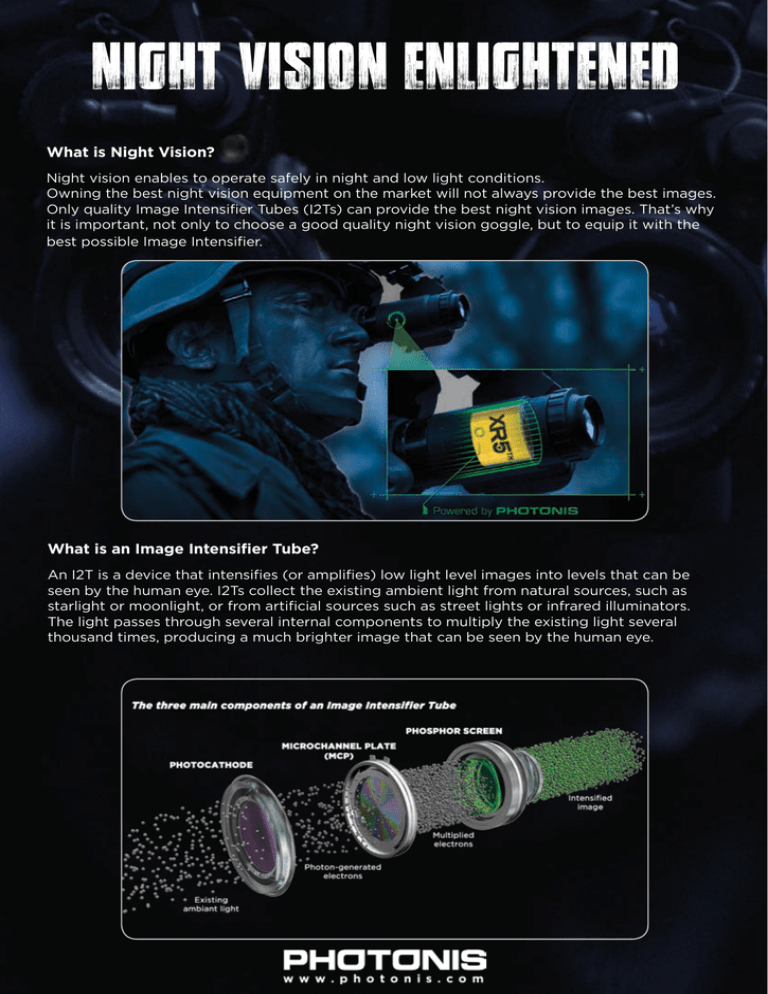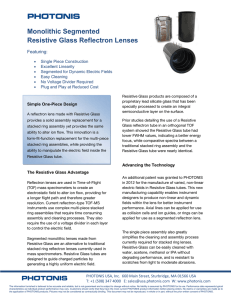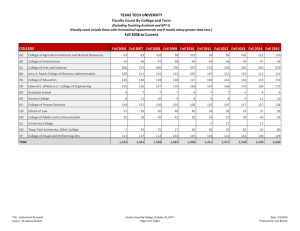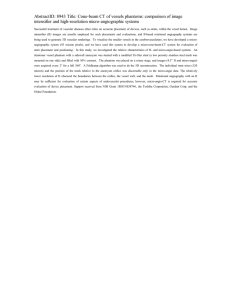
NIGHT VISION ENLIGHTENED
What is Night Vision?
Night vision enables to operate safely in night and low light conditions.
Owning the best night vision equipment on the market will not always provide the best images.
Only quality Image Intensifier Tubes (I2Ts) can provide the best night vision images. That’s why
it is important, not only to choose a good quality night vision goggle, but to equip it with the
best possible Image Intensifier.
What is an Image Intensifier Tube?
An I2T is a device that intensifies (or amplifies) low light level images into levels that can be
seen by the human eye. I2Ts collect the existing ambient light from natural sources, such as
starlight or moonlight, or from artificial sources such as street lights or infrared illuminators.
The light passes through several internal components to multiply the existing light several
thousand times, producing a much brighter image that can be seen by the human eye.
Operation in High Light Levels
High light conditions can be steady, such as a full moon, or sudden, such as during or straight
after an explosion. Prolonged exposure to high light can be harmful to an Image Intensifier.
Operation in Low Light Levels
Seeing in low light levels is critical to improve situational awareness.
The darker it is, the closer the viewer needs to be to detect, recognize or identify any danger.
There are two key factors that determine the Image Intensifier’s ability to see in low light:
Signal-to-Noise Ratio (SNR) and Gain.
SNR
SNR typically defines how much system noise interferes with the image. SNR measurements
have been standardized to allow for better comparison. In very simple terms, a higher SNR level
is better than a lower one when measuring in similar light conditions.
Look for a SNR that offers minimal and typical ratings of 21 or higher.
Gain
Gain is defined as the number of times the Image Intensifier amplifies the light.
This specification should match the night vision device into which it is interated.
If the night vision device has an External Gain Control, providing an Image Intensifier
with a greater gain range also provides a more versatile system for the user.
Low Gain
High Gain
Limiting Resolution
Limiting Resolution is the resolution measured in line pairs per mm (lp/mm), that the viewer can
distinguish. Most I2Ts have a limiting resolution between 60 and 72 lp/mm.
A higher number in this measurement can produce a sharper image; however, this could be
subjective. The Limiting Resolution should be related to Modular Transfer Function.
Modular Transfer Function
Modular Transfer Function (MTF) is the ratio between contrast and resolution across a range
of frequencies (line pairs).
This is an inverse relationship; fewer line pairs will produce a high percentage of contrasting
resolution, while greater line pairs will produce a poorer one (see images below).
A good quality I2T will produce a linear relationship that preserves as many details as possible
in a wide range of lighting conditions.
100% Contrast input image
Options
Output Image: The contrast decreases
as lines become thinner and thinner
The ability to customize an I2T to the user’s specific mission or operational
requirements is critical. Light conditions of an aviator pilot will be different from those
of a soldier deep in the jungle or a hunter in mountainous terrain. PHOTONIS offers
several options in its complete line of Image Intensifiers that can be adapted to suit.
Auto-Gating (ATG)
Auto-gating provides added protection from sudden bright light events.
This function operates constantly by rapidly and continually switching on and off
the I2T to maintain up to 90% of MTF while protecting the I2T and the soldier’s eyes.
SWaP
Reducing the load on a soldier is a constant challenge.
PHOTONIS offers a 16mm Image Intensifier
that reduces power consumption and weight
while maintaining the provision of high quality images.
Phosphor Screen Color
PHOTONIS provides various phosphor screens to create a more realistic image.
Phosphor selection is often a personal preference. Users find that alternative phosphor colors
provide less eye fatigue and faster recognition. PHOTONIS provides several of phosphor color
options.
PHOTONIS France S.A.S.
Avenue Roger Roncier
19100 Brive La Gaillarde
France
T. +33 (0)555 86 37 00
F. +33 (0)555 86 37 69
P43
PHOTONIS Netherlands B.V.
Dwazziewegen 2, 9301 ZR Roden
P.O. Box 60, 9300 AB Roden
The Netherlands
P45
Contact : nightvision@photonis.com
Website : www.photonis.com
T. +31 (0)505 01 88 08
F. +31 (0)505 01 14 56
© Copyright 2015, PHOTONIS Technologies. All Rights Reserved.
The information furnished is believed to be accurate and reliable, but is not guaranteed and is subject to change without notice. No liability is assumed by PHOTONIS for its use. Performance data
represents typical characteristics as individual product performance may vary. Customers should verify that they have the most current PHOTONIS product information before placing orders. No
claims or warranties are made as to the application of PHOTONIS products. Pictures may not be considered as contractually binding. This document may not be reproduced, in whole or in part,
without the prior written consent of PHOTONIS.
SNV-Guide | JULY-2015-1
P22








